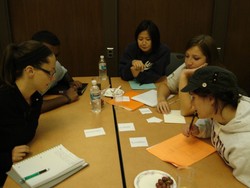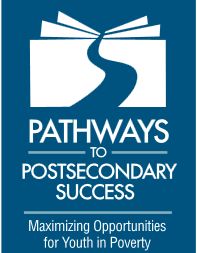
This blog focuses on my scholarship in my five research projects: learning assistance and equity programs, student peer study group programs, learning technologies, Universal Design for Learning, and history simulations. And occasional observations about life.
2016 Annotated Bibliograpy of Postsecondary Peer Cooperative Learning Programs Updated

This annotated bibliography does not attempt to be inclusive of this broad field of literature concerning peer collaborative learning. Instead, it is focused intentionally on a subset of the educational practice that shares a common focus with increasing student academic achievement and persistence towards graduation.
The seven student peer learning programs included in this bibliography meet the following characteristics: (a) the program must have been implemented at the postsecondary or tertiary level; (b) the program has a clear set of systematic procedures for its implementation that could be replicated by another institution; (c) program evaluation studies have been conducted and are available for review; (d) the program intentionally embeds learning strategy practice along with review of the academic content material; (e) the program outcomes include increased content knowledge, higher final course grades, higher pass rates, and higher college persistence rates; and (f) the program has been replicated at another institution with similar positive student outcomes. From a review of the professional literature, six programs emerged: (a) Accelerated Learning Groups (ALGs), (b) Emerging Scholars Program (ESP), (c) Peer Assisted Learning (PAL), (d) Peer-Led Team Learning (PLTL), (e) Structured Learning Assistance (SLA), (f) Supplemental Instruction (SI), and (g) Video-based Supplemental Instruction (VSI). As will be described in the following narrative, some of the programs share common history and seek to improve upon previous practices.Other programs were developed independently.
Regrets for scholarship I have overlooked. Please send me items you think should be included in the next edition. Happy reading.
MAEOPP Center 2015 Best Education Practices Directory
 MAEOPP Center 2015 Best Education Practices Directory
MAEOPP Center 2015 Best Education Practices Directory
Copyright ©2015 by Mid-America Association of Educational Opportunity Program Personnel (MAEOPP) and the University of Minnesota by its College of Education and Human Development, Department of Postsecondary Teaching and Learning, Minneapolis, MN.
MAEOPP is pleased to release the 2015 directory of peer-reviewed education practices approved by the MAEOPP Center for Best Education Practices. Each practice has undergone a rigorous external review process. This directory contains those approved at the promising and validated levels. Readers can use this publication as a guide for implementing the evidence-based education strategies contained within it. Detailed information about the education practice purposes, educational theories that guide the practice, curriculum outlines, resources needed for implementation, evaluation process, and contact information are provided by the submitters of the practice who have practical experience implementing it. Consider using them with current programs and in grant submissions that require evidence-based practices to improve student success.
The thirteen practices approved thus far by the MAEOPP Center represent each of the five major TRIO grant programs: Educational Talent Search, Upward Bound, Educational Opportunity Centers, Student Support Services, and Ronald E. McNair Postbaccalaureate Achievement Programs. One practice is from a GEAR UP program. For readers unfamiliar with TRIO programs, a short history is provided. While the education practices come from TRIO and GEAR UP programs, they could be adapted for use with nearly any student academic support and student development program. These programs are incubators of best practices to serve the needs of historically underrepresented students and the general student population as well.
Integrated Learning Course for Entering TRIO College Students: Outcomes of Higher Grades and Persistence Rates
Integrated Learning Course for Entering SSS College Students. University of Minnesota (approved Validated Practice 8/10/14) Taken from the abstract: In 1972, the TRIO program leaders at the University of Minnesota developed the Integrated Learning (IL) course to meet academic and transition needs of their Upward Bound (UB) students. These courses were offered during the UB summer bridge program for its students who were concurrently enrolled in academically-challenging college courses following graduation from high school. Later, use of IL courses shifted from the UB program to the college-level TRIO Student Support Services program. Long before the widespread use of learning communities within higher education, the IL course is an example of a linked-course learning community. A historically-challenging course like an introductory psychology is linked with an IL course. The IL course is customized to use content of its companion class as context for mastering learning strategies and orienting students to the rigor of the college learning environment. For the past four decades, the IL course approach has assisted TRIO students improve their academic success in the rigorous academic environment as well as acclimate to the social climate of the University of Minnesota (UMN), one of the largest universities in the United States. UMN is a Research I Intensive public university with highly selective admissions and high expectations for students by the course professors. Two quasi-experimental studies examined the possible benefits of the IL course. One was in connection with a General Psychology course. The IL course students earned statistically significantly higher final course grades than nonparticipants. Another study with a General Biology course replicated the results of higher final course grades for the IL course students. The IL courses fostered not only higher final course grades, but also expanded positive study behaviors and their metacognitive skills necessary for academic success. [Click on this link to download this best education practice.]
2013 Report: Pathways to Postsecondary Success Maximizing Opportunities for Youth in Poverty

By Daniel Solórzano, Amanda Datnow, Vicki Park, and Tara Watford with Lluliana Alonso, Virginia Bartz, Christine Cerven, Nichole Garcia, Karen Jarsky, Nickie Johnson-Ahorlu, Makeba Jones, Maria Malagon, Jennifer Nations, Kelly Nielsen, Mike Rose, Yen Ling Shek, and Susan Yonezawa.
Within the context of the country’s economic downturn and its need for greater postsecondary participation, Pathways to Postsecondary Success: Maximizing Opportunities for Youth in Poverty was designed to provide scholarship and policy recommendations to help improve educational outcomes for youth in low-income communities. This final report of the five-year Pathways project provides findings from a mixed-methods set of studies that included national and state analyses of opportunities and obstacles in postsecondary education (PSE) for low-income youth, detailed case studies of approximately 300 low-income young adults preparing for or pursuing PSE in three California counties, and the development of a set of indicators to monitor the conditions in community colleges. This project was supported by the Bill & Melinda Gates Foundation.
Key Findings: What Matters Most?
Our study revealed five key things that matter most for understanding and improving low-income students’ success in postsecondary education.
1. Student Voices Matter. Having numbers that show how many students enroll and persist in postsecondary education is important, but unless we understand from students why these outcomes occur, we run the risk of misunderstanding patterns and implementing ineffective interventions. Hearing student voices is essential to understanding their pathways to and through postsecondary education.
2. Diversity Matters. Low-income youth are a diverse group with a wide range of experiences. Paying
attention to the similarities and differences in this population of students can help us better plan college success initiatives.
3. Assets Matter. Deficit approaches blame low-income students for their lack of success, or they blame educational institutions for failing students, often without recognizing the challenging fiscal, policy, and practical constraints they operate within. In work designed to improve student success, it is essential to focus on both student and institutional assets. Our research uncovers the remarkable strengths students bring and the many positive programs that exist in educational institutions. This asset-based approach helps us understand how to design programs that better tap into and foster students’ strengths in order to support college success.
4. Connections Between K–12 and Higher Educat ion Matter. Postsecondary success is not a story that begins once a student sets foot on a college campus. High quality K–12 schooling and a host of college preparatory resources and activities must be provided in order to ensure college-going success for all students.
5. Institutional Supports and Conditions Matter. To ensure that low-income students’ college aspirations are affirmed and their academic needs are met, institutional supports are essential. As students persist to and through college, they face critical transitions along the way, and certain conditions function as a “guard rail” for keeping them on the path towards college completion.
In sum, low-income students are a diverse group who bring many assets to the educational enterprise. Their talents need to be fostered in order for them to realize the gains that education can bring to them, to their families, and to society as a whole. Supporting low-income students in postsecondary education requires an institutional commitment to their success, high quality curricula and instruction, ongoing advising and mentoring, integration of support services and resources, and streamlined pathways to completion (West, Shulock, & Moore, 2012). To support student success, four provisions—maps, compass, fuel, and tools—are necessary to help students understand their pathways and stay on track as they navigate their college experience. We observed many positive examples of these elements in our research. The challenge is to make these conditions a reality for more students.
College Can Be Complicated: Low-Income Single Mothers’ Experiences in Postsecondary Education

By Christine Cerven, Vicki Park, Jennifer Nations, and Kelly Nielsen. Community colleges play a central democratizing role in the U.S. postsecondary education system. These institutions pride themselves on a long history of open admissions policies that uphold their mission of serving all segments of society. Indeed, if not for community colleges, the overall higher education system would enroll far fewer racial and ethnic minorities and fewer first generation, low-income, and immigrant students (Bragg & Durham, 2012). Community colleges serve a diverse student population; 16% of these students are single parents, and a majority of that group are single mothers (Goldrick-Rab & Sorensen, 2010). Of all household types in the United States, those headed by single women continue to have the highest poverty rates. In 2010, 32% of households headed by single females were poor, compared to 16% of those headed by single males and 6% of married couple households (National Poverty Center, 2013). Thus, it is reasonable to assume that lowincome single mothers who enroll in community colleges may face a range of challenges as they persist to degree or transfer. Open access policies are not enough to ensure low-income single mothers complete college. For many students, open-access policies make it easier to attend college. However, these policies are only the first step; they do not ensure that these students will persist and complete their goals. For students with limited means, multiple taken for-granted needs must be met in order for schooling to become a realistic part of daily life. For low-income single mothers, these needs include stable housing, steady employment and income, reliable transportation, dependable childcare, and assurance that the basic needs of family members are being met. Only after these necessities are in place can other endeavors such as education become a possibility.
<Click on the following link to download the complete report.>
Latina/o Community College Students: Understanding the Barriers of Developmental Education

By Daniel G. Solórzano, Nancy Acevedo-Gil, and Ryan E. Santos. Latina/o students are the largest and fastest growing group in the K–12 sector of U.S. education (Lee et al., 2011; U.S. Census Bureau,2012). Nationally, there are over 12 million Latina/o students in the K–12 population—23% of the overall total (U.S. Census Bureau, 2011a). In California, 53% of all K–12 students are Latina/o (California Department of Education, 2013). This rapid increase in the Latina/o student population impels us to examine their postsecondary educational pathways. Notably, 80% of California Latina/o postsecondary students enroll in community colleges (Moore & Shulock, 2010).2 As Figure 1 shows, Latina/o enrollment in the California Community College (CCC) system is at an incline, while white student enrollment is declining. In 2010, Latinas/os surpassed the white student population as the largest group in the CCC system. These figures make clear that community colleges represent an increasingly vital postsecondary entry point for Latina/o students. Relatively few Latina/o community college students persist to transfer, obtain a certificate, or complete a degree. The CCC system is designed to provide basic skills education, life-long learning opportunities, Career and Technical Education (CTE), and the opportunity to transfer to four-year colleges. On average, out of 100 Latinas/os in California who enroll in a CCC, four will complete a CTE degree and 14 will transfer to a California State University (CSU) and/or a University of California (UC) campus (Figure 2).3 Therefore, large numbers of students leave school without a certificate or degree. Thus, in spite of increasing enrollment, the community college system also represents the point in the educational pipeline where we lose the greatest number of Latina/o students (see Moore & Shulock, 2010; Ornelas & Solórzano, 2004; Rivas, Perez, Alvarez, & Solórzano, 2007; Solórzano,
Villalpando, & Oseguera, 2005).
Unequal Experiences and Outcomes for Black and Latino Males in California’s Public Education System

By John Rogers and Rhoda Freelon. Across the nation there is growing interest in improving the situation of young men of color, who are underrepresented in higher education and dramatically overrepresented in the criminal justice system (Lee & Ransom, 2011). Numerous studies have documented that black males enrolled in school often lag behind their peers academically, have less access to rigorous coursework, experience racial bias from school personnel because of lower expectations for boys of color, and are more likely to drop out (Gregory, Skiba, & Noguera, 2011; Holzman, 2010; Howard, 2008; Jackson & Moore, 2006; Sharon et al., 2010). Although it would be reasonable to expect that Latino males face similar challenges, there are few comparable studies that reveal their experiences. Given the new demographic realities facing the nation—and facing California in particular—it is important that we gain a better understanding of how both groups fare in the state’s public K–12 and postsecondary education system. The research described in this policy brief is part of a larger study, Pathways to Postsecondary Success, which examines the educational pathways of America’s low-income youth, especially in California. We focus here on young black and Latino males because they are nearly 3.5 times as likely as white children to live in poverty (Davis, Kilburn, & Schultz, 2009) and, in comparison to many other California youth, experience relatively low high school and college graduation rates.2 With these issues in mind, we sought answers to the following questions:
- What inequities do Latino and black males encounter in California’s public schools?
- What disparities in educational outcomes do Latino and black males in California face?
- Are some public high schools better than others at promoting the achievement and success of these particular subgroups? What characteristics do successful schools share?
